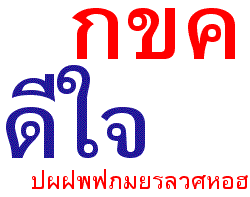
Parts of the Thai alphabet and a couple of words.
Contrary to what many people assume, the Thai written language is not idiomatic like Chinese, Japanese and other north Asian languages. Thai uses an alphabet of vowels and consonants just like western languages. There, however, the similarities end. The Thai alphabet is derived from Pali, the language from which almost all Southeast Asian languages originated and still the common language of Buddhism, sort of an Asian Latin.
Perhaps the hardest thing for westerners to get the hang of are the tones. There are five in all: low, middle, high, rising and falling. The multitude of tones is one reason why the Thai alphabet has 44 consonants and 16 vowels, yet really has no more sounds than western languages. The result is a number of words which are all rendered as khao in Roman script, but which can mean 'rice', 'white', 'in' or 'news' depending on how they are spelled and pronounced.
Fortunately, most of the common words that you may want to learn as a tourist are relatively easy and don't depend too much on tones to be understood. One thing that can be a little difficult for westerners to grasp is the personal pronouns and 'terminators.' Personal pronouns ("I") are gender-specific in Thai. In other words, the word you use depends on whether you are male or female. Thai also uses a spoken 'terminator' to mark the end of sentences, and these too are gender-specific.
About Transliterations
The transliteration of Thai words such as people and place names into Roman script words that can be pronounced something like the Thai original is a real challenge, even without trying to reproduce the tones. There is no accepted standard for doing this and, unfortunately, the common practice among Thais themselves makes it even harder.
The big problem derives from the fact that Thai consonants can have different sounds depending on whether they appear at the beginning or end of a word. For example, letters that are transliterated as 'N', 'R' and 'L' at the beginning of a word are all pronounced as 'N' at the end of a word, yet Thais invariably transliterate letters using their beginning sound regardless of where they actually appear in the word. So, the name of the province where Pattaya is located is almost always spelled 'Cholburi' even though it is pronounced 'Chonburi'.
The big problem this in turn presents us in this guide is whether we should spell Thai words the way you'll see them on street signs or the way they are pronounced. We've generally gone by the way you're likely to see them on signs and maps.
Other things to be aware of when reading transliterations of Thai words:
'Ph' is used to transliterate a soft 'P' as in 'put'. It is never used to make an 'F' sound. 'P' on its own is used for a hard 'P' which can sound almost like 'B'.
'Th' is used to transliterate a soft 'T' sound as in 'too'. Thai does not have a 'th' sound as in 'the'.
'Kh' is used for a soft 'K' sound, while 'K' on its own is a hard 'K' which is close to a 'G'.
Learning Thai
You can stock up on some stock phrases by reading our article on basic Thai words. Another free site with tons of words for the tourist is Thai-Language.com. Another thoroughly modern option is Langhub.com, which features free downloadable MP3 files to help you learn Thai.
Temple Terminology
Throughout this guide, as we describe Thai temples, which are often among the main tourist sights, we use the standard Thai terms for the various parts of a temple. See our guide to temple terminology for a complete glossary.